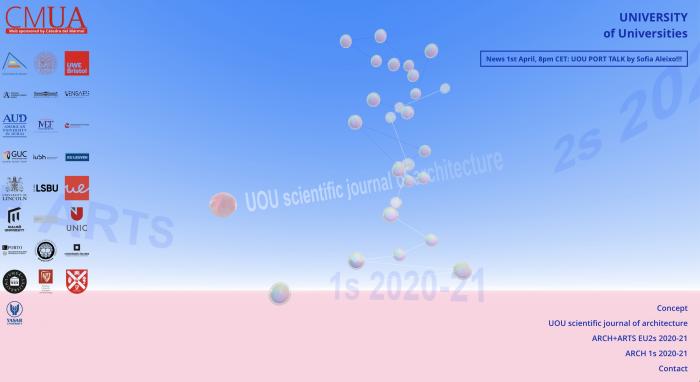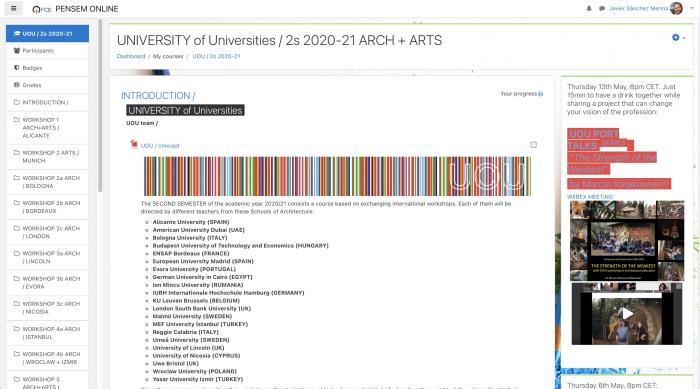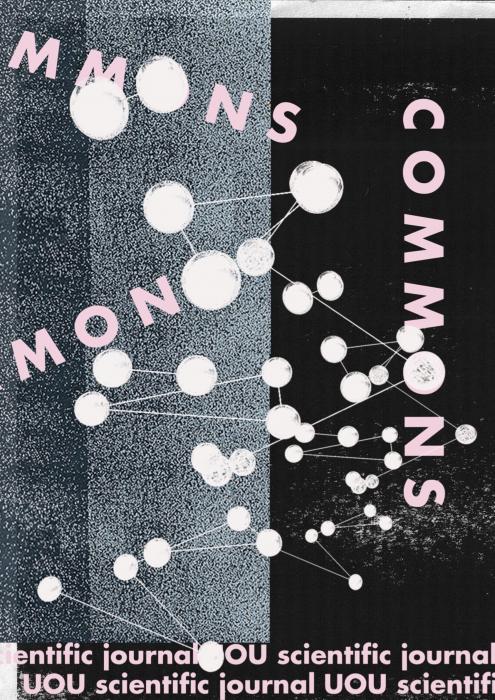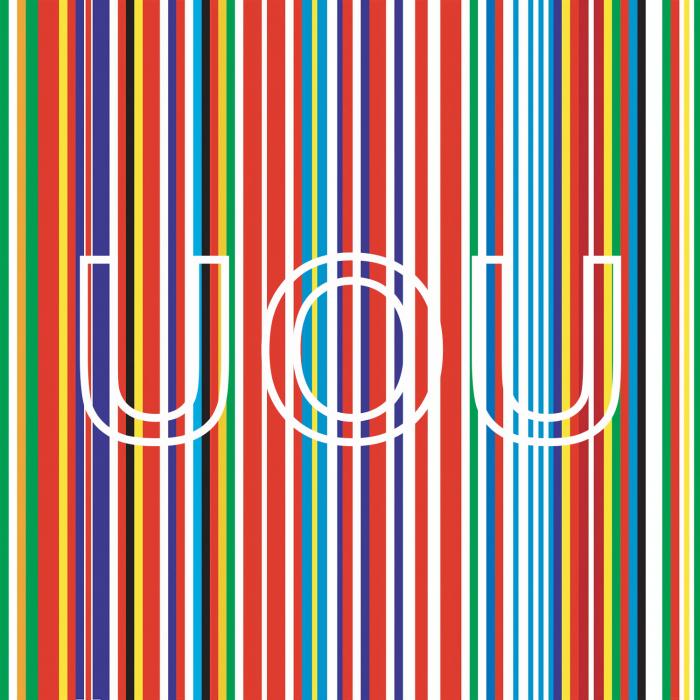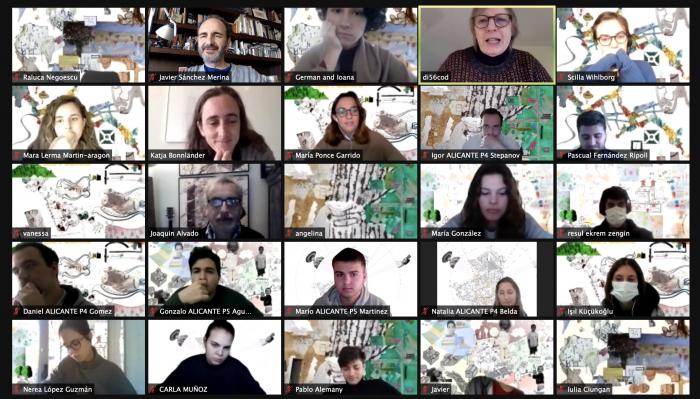I. SUMMARY INFORMATION
Project
268009
Status
Submitted
Award category
Interdisciplinary education models
You want to submit
NEW EUROPEAN BAUHAUS AWARDS : existing completed examples
Project title
UOU. University of Universities.
Full project title
UOU. https://uou.ua.es/ https://moodle2019-20.ua.es/pensemonline/course/view.php?id=502
Description
UOU
https://uou.ua.es/
UNIVERSITY of Universities / ARCH and ARTS is an international learning project based on teaching and knowledge exchange, with the aim to help to complete ERASMUS
It has been developed by teachers from 25 European and non-European universities, starting in the first semester on 2020-2021, and will span in the future. An important aim for this collective experience is the opportunity to design and build a Digital Platform capable to house our future European University.
Where was your project implemented in the EU?
Spain
Valencian Community
Alicante
Alicante
03503
When was your project implemented?
Has your project benefited from EU programmes or funds?
No
Which programme(s) or fund(s)? Provide the name of the programme(s)/fund(s), the strand/action line as relevant and the year.
II. DESCRIPTION OF THE PROJECT
Please provide a summary of your project
UOU
https://uou.ua.es/
Last academic year 2019/20 finished with a debate on the University. Many teachers missed the face-to-face teaching and saw online teaching that tried to mimic the studio as provoking a physical and intellectual distance with the students. In some cases that might have influenced negatively upon student attainment. However, others saw some positive outcomes: Many of us, working in architectural design studios with an already international emphasis have not only seen highly valued results from our students, but have also discovered, in a natural way, a new pedagogy that does not try to emulate face-to-face teaching.
The academic year consists a course based on exchanging international workshops. Different teachers from these Schools of Architecture and Art direct each of them:
ARCHITECTURE
Alicante University (SPAIN)
American University Dubai (UAE)
Bologna University (ITALY)
Budapest University of Technology and Economics (HUNGARY)
ENSAP Bordeaux (FRANCE)
European University Madrid (SPAIN)
Evora University (PORTUGAL)
German University in Cairo (EGYPT)
Ion Mincu University (RUMANIA)
IUBH Internationale Hochschule Hamburg (GERMANY)
KU Leuven Brussels (BELGIUM)
London South Bank University (UK)
Malmö University (SWEDEN)
MEF University İstanbul (TURKEY)
Reggio Calabria (ITALY)
Umeå University (SWEDEN)
University of Lincoln (UK)
University of Nicosia (CYPRUS)
Uwe Bristol (UK)
Wroclaw University (POLAND)
Yasar University Izmir (TURKEY)
ART
Academy of Art -Therapy – Munich (GERMANY)
Porto University – Facultade de Belas Artes – (PORTUGAL)
Reykjavik University of Arts (ICELAND)
Since there are more universities than workshops, students are able to choose what kind of education they want to follow.
This is what we call the UNIVERSITY of Universities and lays the foundations of a proposal for a EUROPEAN UNIVERSITY that completes the ERASMUS program.
Please give information about the key objectives of your project in terms of sustainability and how these have been met
Experience has shown that the sustainability of the developed connections and products is a challenge to any European project. Nevertheless, the consortium believes that sustainability of the project connections and results are depending on effective dissemination and exploitation activities:
- The intangible project results of the learning, training and teaching activities will have a positive impact on the quality of learning in the participating institutions. The new Digital
Learning Platform will be fundamental to sustain the working group meetings beyond the scope of the project. The IPs and the staff development seminars will be developed in such a way that they can provide a model for future events that can be developed by institutional budgets and regular grants. There will be a positive and lasting impact on the quality and relevance of creative collaborative learning (in the context of working with disadvantaged and vulnerable groups, in order to facilitate well-being, empowerment and social inclusion) in the partner institutions and beyond.
- It will be mainly the partner institutions that will be responsible for their implementation concerning the exploitation of the tangible project results. It is expected that the implementation of the project results will be effective by involving persons in the institutions that are closely connected to teaching, curriculum development and management.
- The joint development of the curricula will ensure a clear structure for the cooperation between partners and the continuation of the development of expertise.
- As mentioned above, information about the project and its results will remain available on the project website for large audiences beyond the duration of the project.
We are late for the digitalization on education. We need learning machines, but learning people to create common knowledge.
Please give information about the key objectives of your project in terms of aesthetics and quality of experience beyond functionality and how these have been met
March 2020 obliged us to stop and reflect on our daily routines. It was the beginning of a new way of thinking. If the pandemic provoked instant changes in our lives from its very beginning, with the passing of months it has become clear that many of these changes are not transient. They will remain as a “new normality”.
This project is a reflection on the opportunities for the International Teaching that have emerged out of the lockdown brought about by the pandemic in Europe and beyond.
As academics running separate studios our objective, established well before the pandemic, has always been an internationalization of architectural education. The internationalization we speak of goes well beyond simply teaching through the medium of English to students on Erasmus exchange enjoying a new local culture. Therefore, it is important to state right from the beginning that the online teaching demanded by a lockdown of our traditional studios is just a tool to reach that objective.
WHAT DO WE MEAN BY “INTERNATIONALIZATION”?
The teaching of architecture is ‘prescribed.’ By that, we mean that in each of our countries there is a controlling body, which regulates the discipline and prescribes a level and type of education for those seeking entry to it. Students aspiring to be architects follow the curriculum and are thereby formed to operate in this prescribed system. Even though academic staff.
What if they were able teach beyond the geographical and spatial limits imposed by this prescription of architectural education? It also goes for students. What we mean by ‘internationalization’ is a release from constraint for a moment that allows students to be exposed to experts from different paradigms of architectural education.
Each expert brings his or her specialist knowledge for all to share, regardless of the framework in which they normally teach. It is a celebration of the fact that architecture is a globally taught discipline and that it is good for us all to learn
Please give information about the key objectives of your project in terms of inclusion and how these have been met
These multicultural workshops constitute an international exchange network of studio teachers interested in learning from each other. In this way, the staff participating have not only been suggested by the students, but also, they are teachers willing to accept this basic rule of exchanging knowledge. In addition, this is in fact one of the main values of this pedagogic project: to question the pyramidal system of education, where the students are at the base and the professor on the top. But not only at the top; at the same time often well isolated from other colleagues. Now, the educational model follows a horizontal relationship, everybody teaches, everybody learns.
At the end of each semester, there will be a series of International Workshops designed to work better online than face-to-face. In addition, just as with the Surrealists’ exquisite corpse game, every workshop is an addition to the former one. The whole becomes greater than the sum of its parts.
Each studio leader will have the trust of the entire team and the freedom to propose and direct a two-week online workshop, based on the Excellency of his or her specialization, for all the students of the different schools participating in the experience. The other academic staff become tutors in the workshop. After these two weeks, another studio leader takes over with a new workshop, while the former director becomes a tutor of his/her students and so on. That rotating leadership of the workshops maintains the important studio role of
‘Supervisor’ supporting the ‘student’, but also provides for close academic help for the director of each workshop.
The participating universities are from Alicante and Madrid (Spain), Dubai(UAE), Romania, Cyprus, Bristo, London and Lincoln (UK), Umeå (Sweden), Malmö(Sweden), Istambul and Istmir (Turkey), Calabria and Bologna (Italy), Poland, Evora and Porto (Portugal), Belfast (North Ireland), El Cairo (Egipt), Iceland, Munchen and Handburg (Germany)
Please give information on the results/impacts achieved by your project in relation to the category you apply for
1 - To extend the reach of our universities, by bringing together a coordinated team of international teachers with their specific research interests and practice specialisms.
2 - To extend the notion of the classroom beyond its walls. By appreciating the ‘space for learning’ as being more than physical space but instead as being ‘a landscape of life’, we enrich the students’ cultural and learning environment.
3 - To extend the international student experience, until now mainly provided by Erasmus+, to a larger group of students than would otherwise normally have been the case. And,
Subsequently be in a position to bring our new experience to bear on the Erasmus+ program once the pandemic has subsided.
This triple aim of UOU requires, because of the project, the design of a Digital Platform capable to house our future European University. The collaboration of this strategic partnership intends to achieve the following results as well:
- New curriculum for a study program for ERASMUS / Architecture.
- Tools that provide architecture students with opportunities to train and work in an international environment.
- Cross-sectoral learning space through participatory architecture in order to facilitate well-being, empowerment and social inclusion.
- New interdisciplinary approaches through an active dialogue between different cultures.
- Enhanced awareness of the multi-faceted possibilities and roles of the architects in society.
- Increased labor market relevance in the learning provisions.
- Enhanced quality and relevance of higher education in Europe in the field of architecture.
- Enhanced professional development for staff in the participating institutions.
- Increased strategic collaboration between HEIs and professional partners.
Please explain the way citizens benefiting from or affected by the project and civil society have been involved in the project and what has been the impact of this involvement on the project
When looking at the impact of the project and its results beyond the partner institutions, it is crucial to mention that this project serves as an effective model of how cross-border cooperation can function as a tool for institutional development and curricular innovation online. The impact on the participating institutions as described in the paragraph above can only take place when done at the international level, partly because this is where the expertise can be found and combined.
As a result, an impact of the project beyond the project partnership can be expected on:
- The cultural and pedagogic sectors in particular, which will find themselves supported by institutions from online fields that offer commitment and professionally trained experts.
- International community of HEIs that have better understanding of the needs and relevance teaching online.
- The knowledge gained from the project will be contagious to a large group of students who have taken part in the project and their peers who learn about the project results.
- Students in other higher architecture education institutions, who will indirectly benefit from the knowledge gained in this project and from the promotion of European collaboration in the sector as realized by the project, which will provide them with important architectonic and educational experiences and a better preparation for the professional market.
- Officials in quality enhancement agencies, national ministries and European institutions, who will gain greater awareness of the latest developments and specific needs of the online higher education sector.
- The emphasis on community engagement and social inclusion will lead to wider recognition from communities that will participate in the project's activities. This will connect the HEIs in the architecture sector to the outside communities, improving general understanding of their important roles in society, and proving the relevance of investing in these institutions.
Please highlight the innovative character of the project
The project’s innovative character lies in the collaboration between Universities from different countries. The aim is to broaden their scope and social commitment, as well as to highlight their international character.
This thought is important to bear in mind when evaluating why to work in an international way. It is a method that will be reflected in the students’ projects and later in their practices, emphasizing open-mindedness and creative learning.
It is for the first time that these educational centers find the need to work together. These conditions are not limited to one place, but are a global issue. It is therefore important to learn from each other, from partners from north, central and south Europe. The project therefore strives to facilitate and promote going from the local to the global as a sustainable way of thinking and working.
Of course, there are many challenges. Co-ordinating, language(s) of instruction, language(s) of tutoring, group work online teaching and timetables are but just a few. That is the point. Without recognising the challenges and being flexible in our approach to them, we will not experiment and ultimately find a common workable approach. A framework of monitoring and feedback will be established from the start to give all involved the equal space to comment and influence the direction of this year. The design staff will be holding regular meetings and join this project in a spirit of being open to learning from it.
Already steps have been taken to address some of these worries. For example, one of the workshops #05 explicitly seeks to move away from a default use of the English language to explore communication of architectural intent through other ‘languages.’The underlying principle is one of inclusivity and engagement. There is no coercion and interpretation of and experimentation with the briefs is encouraged.
The coordinated monitoring of feedback will play an important part in the development of a future Europ Uni.
Please explain how the project led to results or learnings which could be transferred to other interested parties
The expected impact on the institutions as described above will be challenging to measure in the short term. As with any curricular innovation and institutional development processes, the long-term effects of these can only be measured in student and staff satisfaction surveys years after they have been implemented, which goes beyond the scope of this project.
A positive learning and transfer on the quality of the participating institutions through:
- A reinforced situation concerning new opportunities and the quality of modules in the partner institutions. Taking affect through new and improved curriculum built on the learnt learning approaches from the EU project.
- Teaching staff that is updated and re-trained with information on innovative learning approaches, leading to enhanced quality of the education in a close connection with society and communities.
- An approach to European and international cooperation that brings lasting benefits to the institutions. This results in higher numbers of student and teacher exchanges between the partner institutions, as well as exchanges of higher quality overall, through a shared understanding of curricula.
- Professional partners that are better informed on learning approaches and curriculum in higher education that meet with current social issues, leading to an enhanced quality in collaboration.
- The HEIs participating in the project gain a valuable experience of working with professional partners, through activities which include students, academic staff and individuals from the professional environment. This leads to enhanced relevance of the education.
Through this development of curricular innovation with a lasting qualitative effect, it is expected that institutions will become more successful, competitive and attractive vis-a-vis their core competitors , and as a result will attract students and teachers of higher quality that are more prepared to meet never ceasing changes in society.
Is an evaluation report or any relevant independent evaluation source available?
No
III. UPLOAD PICTURES
IV. VALIDATION
By ticking this box, you declare that all the information provided in this form is factually correct, that the proposed project has not been proposed for the Awards more than once under the same category and that it has not been subject to any type of investigation, which could lead to a financial correction because of irregularities or fraud.
Yes
